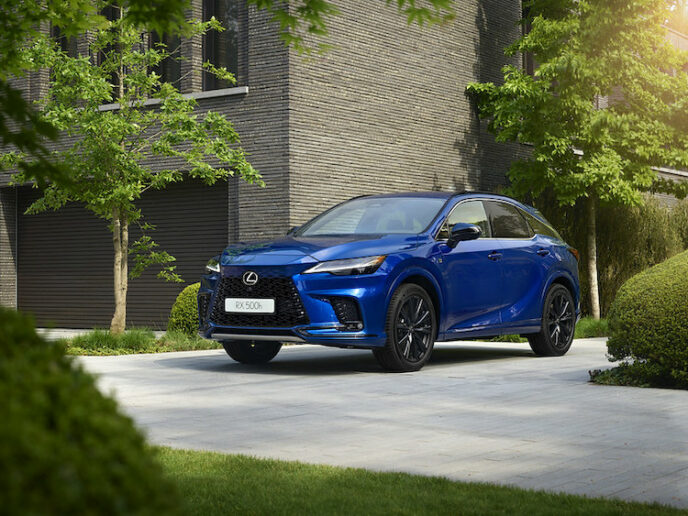
Lexus has revealed its all-new RX SUV to global markets but the confirmed model line-up, specifications, and on sale date for Australia won’t be announced until later this year
The fifth-generation RX also represents the next step in the Lexus Electrified vision with the introduction of a new high-performance hybrid (HEV) and plug-in hybrid (PHEV) available in certain markets.
“The RX is a foundation of the Lexus brand both globally but also here in Australia ever since its local introduction in 2003,” Lexus Australia chief executive John Pappas says.
Lexus has sold more than 3.5 million examples of the RX throughout 95 countries and regions, including more than 40,000 in Australia since debuting locally in 2003.
The all-new SUV range is spearheaded by a new hero model in the new RX 500h F Sport Performance, powered by Lexus’ first turbocharged HEV 2.4-litre engine with high-output eAxle rear motor.
The RX 500h F Sport Performance has a Direct4 all-wheel drive force system using electrification technology, as shown on the RZ 450e, Lexus’ first battery electric vehicle (BEV) built on its own dedicated platform.
It’s greater handling, stability and driving enjoyment is bolstered by six-piston front brakes, Adaptive Variable Suspension (AVS), Dynamic Rear Steering (DRS) and 21-inch aluminium wheels.
Additional powertrains announced in the global reveal include a turbocharged 2.4-litre petrol engine, 2.5-litre HEV delivering low fuel consumption and a 2.5-litre PHEV with class-leading EV cruising range and powerful acceleration performance. Two-wheel drive and all-wheel drive will be offered.
The powertrains and model configurations for the Australian market are yet to be confirmed.
While retaining its overall length of 4,890mm1, the all-new RX has grown on the inside to deliver greater comfort and convenience. Wheelbase is increased by 60mm (to 2,850mm) and the distance between front and rear hip point has increased by 12mm to liberate more interior space. An extra 50mm is added to the rear luggage compartment.
Overall width is increased by 25mm (to 1,920mm), front track widened by 15mm, rear track by 45mm and overall height reduced by 10mm (1,695mm). These footprint changes, together with a 15mm reduction in centre of gravity and overall weight reduction by 90kg.
Since its global launch in 1997, the RX has been a pioneer in luxury crossovers, focusing on strength and refinement. Like the recently introduced NX and LX, and the RZ BEV unveiled in April, the RX also pursues a unique identity.
This is evident in the all-new RX with its extended wheelbase, low centre of gravity and widened front and rear tracks giving a more planted stance. This is also noticeable from the side view with the raised tip of the bonnet and pushing back of the A-pillar’s base creating a more elongated look, together with the lowered rear edge of the back window.
From the rear, a simple and strong horizontal sweep produces a wide and low look to underline the lower centre of gravity, while also projecting a sense of power and strength. The L-shaped signature rear lenses wrap around the body’s sides to emphasise a wider and lower silhouette.
The spindle design front is now expressed in three-dimensional form, evolving into a new expression called the spindle body. At the front, the body colour is brought down to the lower edge of the Lexus emblem, emphasising the strength of the design while the grille continues to provide cooling functionality.
All F Sport models feature an exclusive front bumper that expresses a wide and low stance and contributes to aerodynamic performance. The F Sport models also gain 21-inch exclusive aluminium wheels.
The grille features an exclusive mesh pattern and has a seamless design that fuses the boundary between the body and the mesh grille, establishing a new and unique F Sport identity. Six-piston brake calipers are now standard on F Sport to achieve more linear and direct brake feel and deceleration.
The RX’s interior is based on the Tazuna concept, a human-centred design philosophy where the driver is intuitively connected with the car to better concentrate on driving, while still creating a spacious interior that encompasses all passengers.
The steering wheel switches are integrated with the head-up display so the driver can keep eyes forward and concentrate on driving. Navigation, audio, and various functions can be operated without the need for extra eye movement or complicated switch functions.
A centre display offers a choice of 14-inch or 9.8-inch dimensions for its integrated functions. Designers paid close attention to details such as the size, shape, layout, and information of the icons, pursuing the optimal placement and shape for intuitive operation, while also taking the frequency of use of each function into consideration.
The instrument panel and dashboard design promote a wide-open horizontal space that envelopes all passengers. In addition, the multi-coloured illumination around the instrument panel creates a spacious, immersive atmosphere even at night.
A new platform increases the distance between the front and rear hip point by 12mm compared to the previous model, resulting in increased rear-seat space. In addition to the lowered floor, the scuff and centre pillar cover have been shaped to ensure that both the front and rear seats have ample space for ease of entry and exit.
Rear luggage space is lengthened by 50mm courtesy of a thinner hatch door while load height is reduced by 30mm for more useful overall luggage space.
A triple-zone independent temperature control system allows for specific temperatures for driver and front passenger as well as rear-seat occupants. There are seat warmers for front and rear seats while air-conditioned seats are available as an option.
Five interior colours are available while a new metallic exterior colour, Sonic Copper, is added to the palette to bring to 10 the number of exterior colours on offer.








